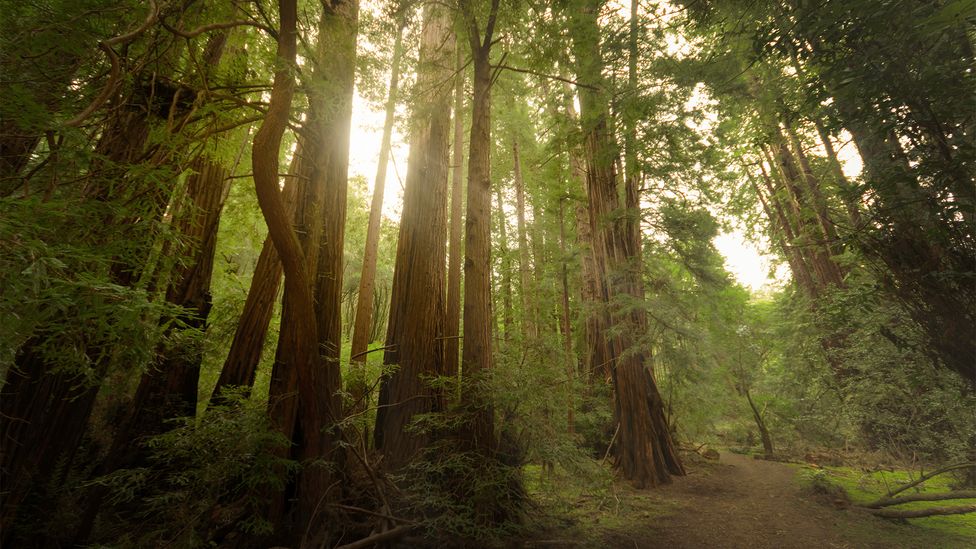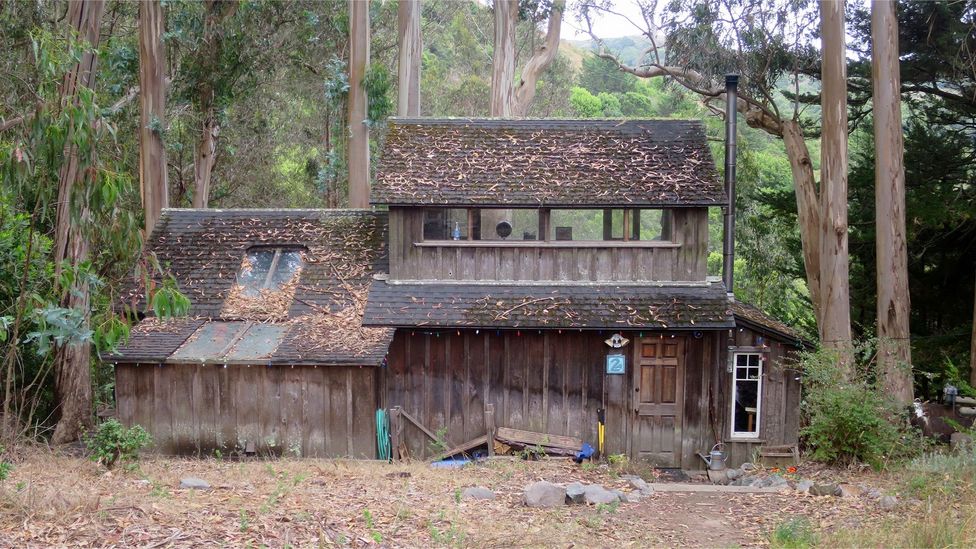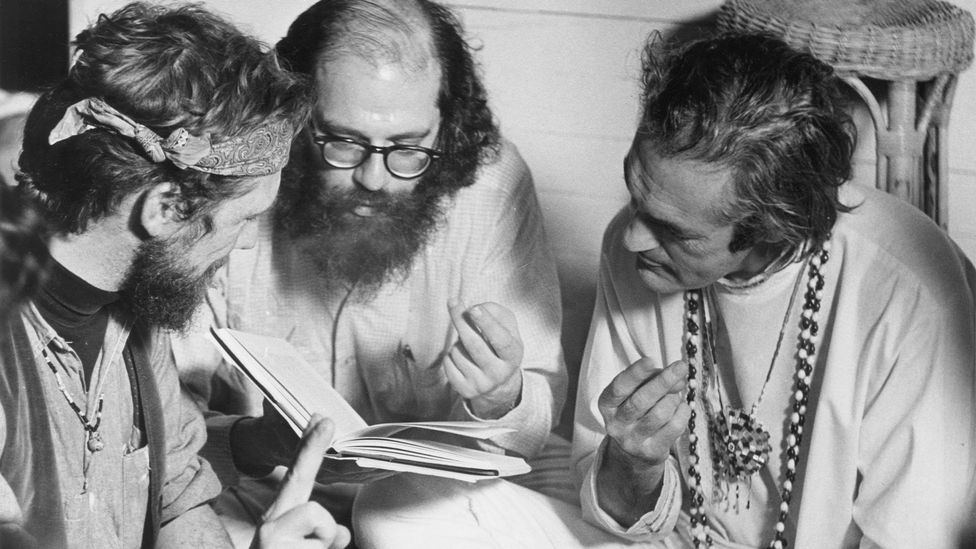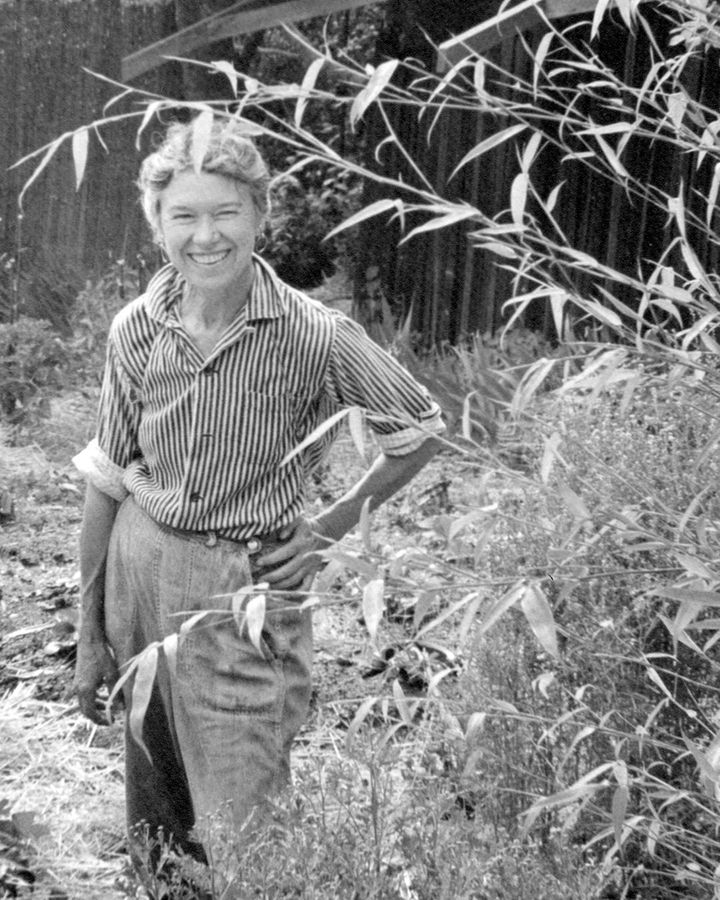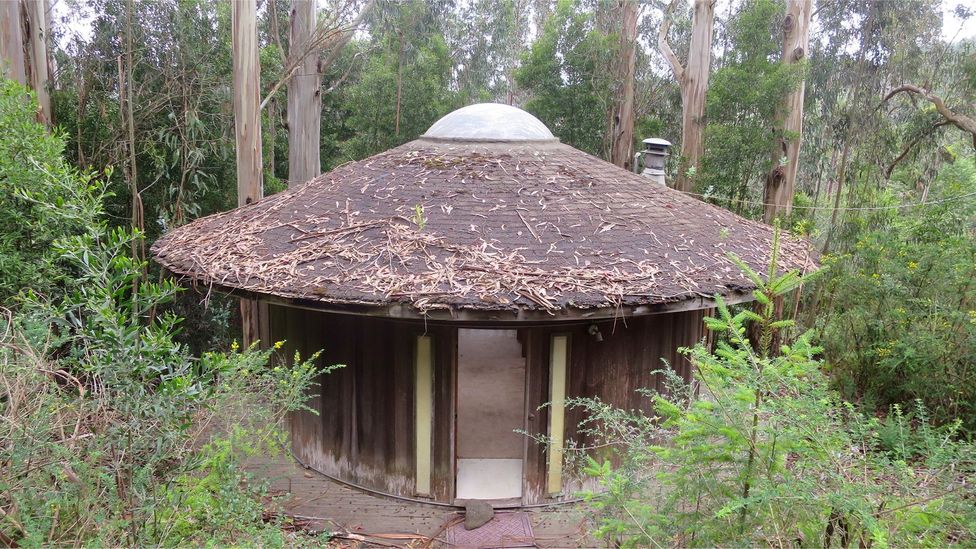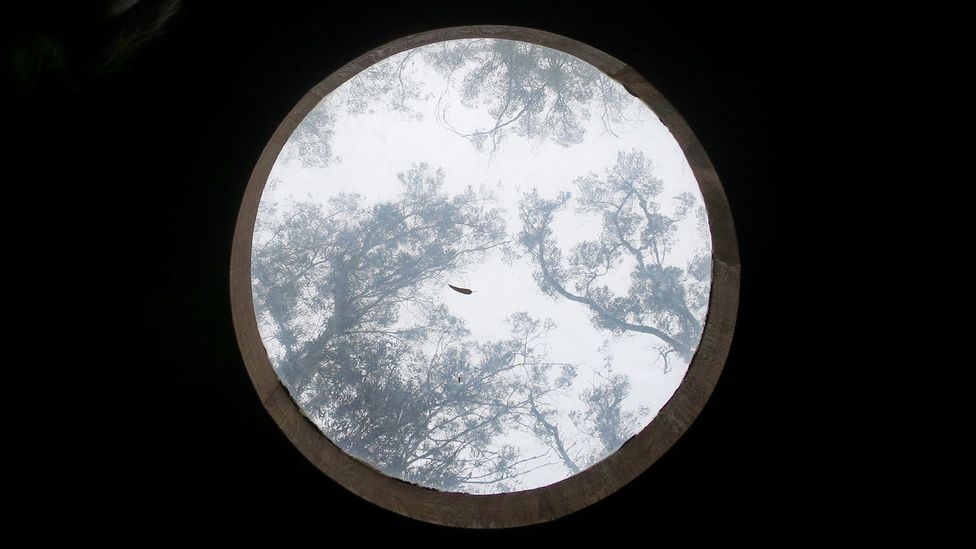In 2022, nearly 800,000 people from around the world visited Muir Woods National Monument just north of San Francisco, California, to marvel at the groves of towering redwoods – among the tallest and oldest trees in the world.
But just a mile and a half from the park's entrance in a separate part of the park, another significant site remains largely unknown, despite its prominent role in LGBTQ+ and counterculture history. Here, tucked deep in a canyon and slowly sinking back into the forest, lie the decaying wooden remnants of Druid Heights, a trailblazing bohemian community that some consider the US' only LGBTQ+ Historic District (a collection of buildings of historical or architectural significance.)
Founded in 1954 by lesbian poet Elsa Gidlow and builder Roger Somers, Druid Heights became a cultural hub that profoundly influenced a multitude of cultural currents during its 30-year heyday, from gay liberation and radical feminism to Zen Buddhism. Like a West Coast version of the Hotel Chelsea or Algonquin Round Table, these 18 architecturally distinctive buildings hidden in the woods served as home, school, workshop and intellectual incubator to an eclectic circle of leading alternative thinkers of their time. The community's importance extended through waves of cultural change, from the Beatnik poets and philosophers of the late 1950s through the psychedelic and spiritual explorations of the '60s and early '70s to the gay liberation, radical feminism and gender politics of the late '70s and early '80s.
A host of luminaries were drawn to the site, among them poets Alan Ginsberg and Gary Snyder; musicians Neil Young, Dizzy Gillespie and members of Fleetwood Mac; actors Lily Tomlin and Tom Smothers; noted feminist law professor Catharine MacKinnon; and activist Margo St James, known for her high-profile campaign advocating for sex workers.
"As scholar Erik Davis put it in my film, Druid Heights was this vortex of social and artistic energy, this community of such illustrious characters, such great art, such huge influence and it was literally off the map," said Marcy Mendelson, director and producer of the documentary Druid Heights. "Going there was like turning the corner into the Shire."
But the resident who first drew legions of visitors to Druid Heights was Alan Watts, a British former Episcopalian minister who is often credited with popularising Buddhism and Taoism in the West. A longtime friend of Gidlow's, Watts gave public teachings at Druid Heights, wrote six of his seminal books in his library on the property and died there in 1973.
"This site is so extraordinary in the quality of its setting, in what was being done there and the lives that were being lived, and you feel that as soon as you step into this landscape," said Charles A. Birnbaum, president and CEO of the nonprofit The Cultural Landscape Foundation, which works to preserve culturally valuable places and includes Druid Heights among its most at-risk sites. "It was a hotbed of creative fulfillment and a place that people felt safe, and when you think about the world today, the need for places where people feel safe is so important."
From this wooded community came books of leading feminist and lesbian thought, Pulitzer Prize-winning poetry, provocative experimental films, recordings of genre-bending jazz and numerous groundbreaking philosophical and spiritual treatises, like Watts' book, The Way of Zen. Gidlow's 1975 book, Ask No Man Pardon: The Philosophical Significance of Being Lesbian, was a landmark of gay liberation, as was the film in which she participated, Word Is Out: Stories of Some of Our Lives, the first feature-length documentary about gay identity made by gay filmmakers.
In her later years, Gidlow continued to publish, give readings and speak at conferences, and gathered a following of younger women whom she mentored at Druid Heights. As author and former part-time Druid Hills resident Hallie Iglehart Austen said: "The vision that these folks, Elsa and Roger in particular, had to just create their own world even outside the bohemian world they'd been part of in San Francisco, was quite remarkable."
Born in England in 1898 and raised in Quebec, Gidlow was only 25 when she wrote On a Grey Thread, the first book of lesbian love poetry published in the US. She had already broken ground by publishing Les Mouches Fantastiques, an underground magazine published between 1918-20 that's considered the first gay publication in North America. Gidlow went on to author 12 more books, including her 1986 autobiography, Elsa, I Come with My Songs, the first explicitly lesbian autobiography not written under a pseudonym.
"Elsa Gidlow holds a place in history that nobody else holds and it is really too bad that she isn't better known," said Marcelina Martin, a close friend of Gidlow's and executor of her literary estate. "It's important that she's not forgotten because of the incredible value of her life. She was herself from the beginning and it didn't matter what was accepted and what wasn't."
But in 1954, having been brought before the California State Senate's Committee on Un-American Activities as a communist sympathiser, Gidlow was ready to escape the spotlight. She purchased a five-acre former chicken farm on the south-western slope of Mount Tamalpais where she could live openly with her partner, Black journalist and activist Isabel Grenfell Quallo. She also had a wider vision: an "unintentional community" where alternative thinkers could live and explore their creativity free from the scrutiny of conventional society.
Realisation of Gidlow's vision fell to Somers, whose swirling lines and fantastical flourishes came to characterise the craftsmanship of counterculture California. Drawing on influences ranging from Japanese art and architecture to Frank Lloyd Wright, Somers partnered with woodworker Ed Stiles to erect an assemblage of whimsical buildings, including the Dragon House, a community centre also known as Twin Peaks for its swooping Polynesian-style roof; Mandala House, designed to resemble a lotus flower; and Watts' Library, a round building with a cone-shaped roof resembling a water tower. The interiors, rich in burnished wood and lit by skylights and stained glass, were so alluring they caught the interest of singer Neil Young, who hired Somers to build out the interior of his tour bus in 1975.
A proficient jazz saxophonist, Somers hosted jam sessions that often turned into all-day or all-night parties that ended in his self-designed redwood hot tub – considered the progenitor of the US' ensuing hot tub craze. As word spread of this magical enclave in the forest, the number of residents swelled to more than 30 and the revels grew larger and more star-studded. "There's a story about someone walking by the hot tub and looking down and there's Judy Collins," Iglehart recalled.
Watts, Gidlow, and Somers all died on the property, and all but a few of these buildings now lie abandoned. And as the years take their toll, these structures have become a centre of contention, with preservationists putting increasing pressure on the National Park Service (NPS) to restore them and open the site to visitors.
The contention dates to 1972, when the NPS announced its intention to take over the land, gaining the residents' compliance with the offer of lifetime leases. In 1977, Druid Heights became part of Muir Woods National Monument and the greater Golden Gate National Recreation Area (GGNRA.) While the NPS initially indicated it intended to preserve the site, little action was taken and most of the buildings are now dilapidated.
Off limits
Since absorbing the area in 1977, the NPS has officially closed Druid Heights to visitors. Yet, those wishing to see the site may do so by hiking a network of trails that encircles the site.
NPS staff attribute the lack of maintenance and restrictions on public access to a lack of funds, safety concerns and a desire to respect the privacy of the handful of residents who remain on one section of the property under the lifetime leases, including Stiles. "We are in the process of developing interpretive materials for Druid Heights, but since it is not open to the public this has not been a priority," said parks spokesperson Julian Espinoza.
Preservationists express frustration with what they see as bureaucratic wrangling and foot-dragging. "They've now spent decades allowing the site to decay without doing anything to preserve it," said Gerard Koskovich, a founding member of the GLBT Historical Society, which maintains the Elsa Gidlow archives. A grassroots group, Save Druid Heights, organised in 2017 to promote awareness, has amassed a trove of historic materials and advocates for the NPS to educate the public about the site.
But there are reasons for optimism, too. After years of research and documentation by the NPS, in 2018 Druid Heights was determined eligible for listing in the National Register of Historic Places (NRHP) at both the local and state level.
Buildings and districts listed on the national registry are deemed worthy of preservation, and the fact that Druid Heights is owned by the federal government confers additional protection, said Shayne Watson, owner of Watson Heritage Consulting. That doesn't mean the park service has to open the site to the public, but they do have to preserve it. "They're on thin ice if they allow those buildings to collapse."
With that possibility becoming ever more likely, Birnbaum expresses the urgency preservationists feel to move the process forward before it's too late. "When you look at other places that have been associated with [LGBTQ+] culture in America, there are really very few places that are as unchanged as Druid Heights. Now that stewards know the history of this place and the fragility of this legacy, they must act."
CORRECTION: A previous version of this story cited an incorrect figure of how many people visited Muir Woods National Monument in 2022. That number has been corrected.
Rediscovering America is a BBC Travel series that tells the inspiring stories of forgotten, overlooked or misunderstood aspects of the US, flipping the script on familiar history, cultures and communities.
---
Join more than three million BBC Travel fans by liking us on Facebook, or follow us on Twitter and Instagram.
If you liked this story, sign up for the weekly bbc.com features newsletter called "The Essential List". A handpicked selection of stories from BBC Future, Culture, Worklife and Travel, delivered to your inbox every Friday.
